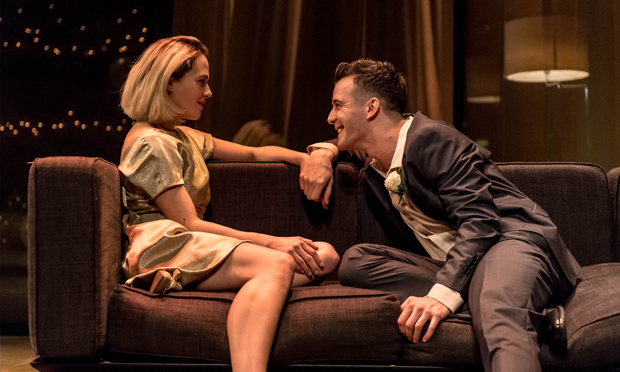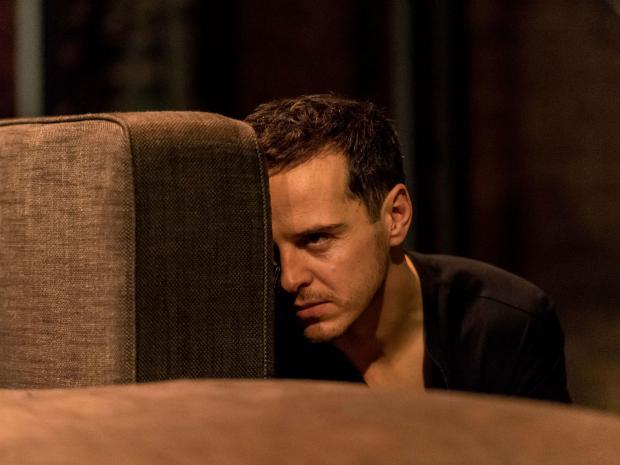I had the great pleasure of seeing this production as a birthday treat to myself (I know, I know), and in the company of my best friend. We knew all about the 4 hour length, and the intensity of what was to come, so we stoked up on a Bill’s brunch, and settled in. Emerging 4 hours later into the evening spring sunshine, we were both blinking back tears, and just looking at each other in shared sadness and amazement!

A word, first, about Andrew Scott. Predictably, the press leaped on the news of his casting, calling it the ‘Moriarty Hamlet’ (thereby erasing Scott’s impressive stage CV, just as they did when they called David Tennant the ‘Doctor Who Hamlet’), and preparing to draw comparisons with Benedict Cumberbatch’s sell-out show at the Barbican. Scott, however, is a far superior Hamlet. With the benefit of an intimate theatre, rather than the Barbican’s cavernous spaces, Scott could half-whisper lines, allow his voice to crack on certain lines, and then pour his heart into shouts or soft utterances as he saw fit. His Hamlet is sweet, sure, and gracious, and surrounded by love, but his desperation at the loss of his father pushes all aside. Crucially, and something that I have often forgotten, is the closeness between the two families. Gertrude is clearly very fond of Polonius; Ophelia and Laertes swamp their father with hugs even as they gently tease his verbosity; Laertes and Hamlet are friends, making the later action all the more upsetting. Hamlet weeps into Ophelia’s shoulder, and while she clearly loves him, her comparative youth makes her seem somewhat out of her depth in the relationship. The scene where Hamlet appears to Ophelia in his ‘mad’ state is shown through the glass doors (more on those later), but here, Hamlet disturbs Ophelia in the bath, and moves from sitting smilingly on the rim of the tub to holding and pulling at her arm. Ophelia’s nakedness, and then shocked appearance in front of Polonius with her fair still damp, suggested a violent edge to that encounter that was all the more shocking.

The staging allowed for illuminating touches about the state of Elsinore. Whereas Tennant’s ‘Hamlet’ made extensive use of CCTV cameras, and Kinnear’s production had guards on stage even during the soliloquies, this Elsinore seems less of a surveillance state, and more of an elegant palace, which nonetheless provides opportunities aplenty for overhearing. The sliding, clear double doors allows the audience to see private conversations and intimate dancing in the background, and characters spot each other through the glass before entering a scene. Those doors came into their own in the ending, where all the deceased characters mingled, talked, and danced, before inviting Laertes, Gertrude, and even Claudius into their midst. It was a moment that might have been sentimental, but was handled beautifully, and providing a gorgeous counterpoint to Hamlet’s earlier musings about the ‘undiscover’d country, from whose bourn /
No traveller returns’.

Pleasingly, given Scott’s star billing, the rest of the cast was also of the highest order. Jessica Brown Findlay’s Ophelia was all the more moving for avoiding the now traditional let’s-strip-off-and-cavort-about kind of madness. She was brought on in a wheelchair, mentally broken and distraught, crushed by Hamlet’s savage rejection and the loss of her beloved father. Juliet Stevenson was once again excellent, infusing Gertrude with a winning sensuality and kindness, and her resolve to meet her death in the final scene was very powerful. Luke Thompson continues to shine as one of our finest young actors: Laertes is a tricky part (mainly because you’re off stage for such a chunk of time), but the buzz cut and the tattoo proved inspiring touches for this young, vibrant, and passionate Laertes, whose distress at the death of his father and the decline of his sister reminded us of how much suffering this play spills out.

The ending, though, dealt the real emotional punch. As ever, the final scene spirals into a hideous bloodshed: the suicidal Gertrude, realising what her new husband has done; Claudius, forced to drink his own poison; Laertes, deeply regretting his anger; and, of course, Hamlet himself. But here, rather than leaving a pile of inert corpses, each one rises, in turn, and moves towards those sliding doors, handing over their watches to the Ghost, who takes the watches, and then lets them pass. (For a particularly enlightening discussion of watches in the play, check out this page). Over goes Laertes’ brand-new shiny number from proud Polonius; over goes Gertrude’s elegant, queen-befitting device. In the performance I saw, Hamlet also reaches to his wrist – only to find that his beloved father’s watch is already in the hands of the Ghost. Ultimately, this meant that Hamlet did not pass through those doors to paradise, but remained on stage, cradled by Horatio, as footage of a huge state funeral and a sad-eyed Fortinbras plays out above their bodies. The final broadcast image, of a photograph of all the now-dead characters, smiling and laughing together, was a terrible reminder of tragedy’s ultimate horror: the division and extermination of family lines.

Just a few quibbles:
- In this production, Claudius confesses his crimes directly to Hamlet, who is armed with a pistol and filled with murderous intent. He clearly isn’t praying privately – it’s a face-to-face confession, to the man whose father has been murdered. I really didn’t understand why the director chose this. If you have any thoughts, please do let me know!
- I missed a real sense of a close friendship between Hamlet and Horatio, a key part of the Tennant Hamlet, for example.